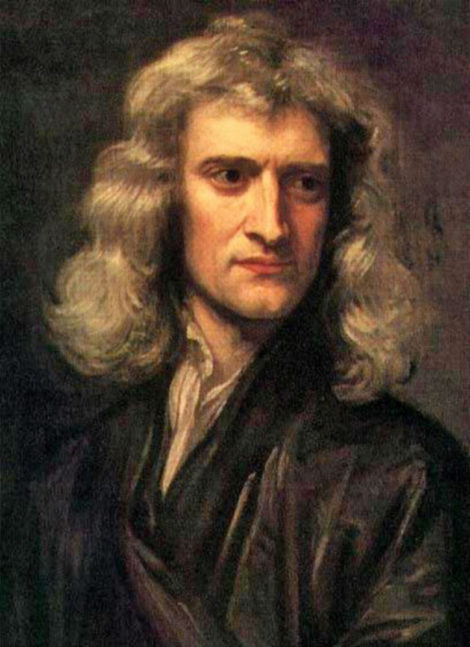
Sir Isaac Newton • Portrait by Godfrey Kneller (painted in 1689). Location: Institute for Mathematical Sciences, University of Cambridge
Most people nowadays think about the apple, the tree and the law of gravitation when the name »Newton« is mentioned. But, let’s start with a story about an alchemist and his dog, Diamond. “O Diamond, Diamond, thou little knowest the mischief thou hast done”, said Sir Isaac Newton as he watched his work of twenty years go up in flames.
Newton was on his quest to discover the Philosopher’s Stone. For twenty years up to that point he had researched, studied, and experimented with alchemy and ancient wisdom that he had documented in his writings. But his favorite dog, Diamond, upset a candle that in its fury burnt so many of Newton’s manuscripts… Whether this is exactly how the fire in his lab happened or not, I find this story extremely endearing, from the symbolic name of his dog to the fury of a candle, all the way to Newton’s exclamation.
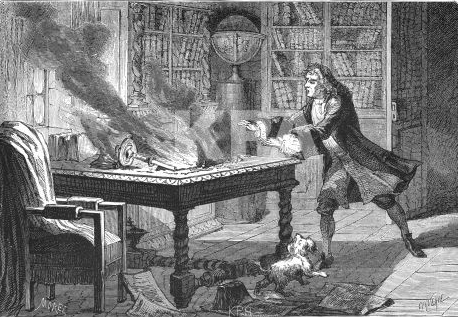
Some historians debate whether Newton actually owned a pet or not. Some say the wind and an open window caused the candle to lit the fire, while Newton himself was on his way to church. Others say, that the whole story about the fire may have been a small incident or none at all. For sure is, that the Newton Project still has many millions of words left to transcribe and to translate and that Newton’s unorganized seeming way of journaling is not very helpful in this regard.
Newton’s worldview was not purely mechanical, as most remember today. It is not to be overlooked that the man was more of a mystic who was passionately seeking the wisdom of the ancients within hermeticism and alchemy. His translation of the Emerald Tablet is a testimony to his interest, passion, and mission.
As F.E. Manuel says in his book »The Religion of Isaac Newton«:»The more Newton’s theological and alchemical, chronological and mythological work is examined as a whole corpus, set by the side of his science, the more apparent it becomes that in his moments of grandeur he saw himself as the last of the interpreters of God’s will in actions, living on the fulfillment of times«.
Sir Isaac Newton’s Life and Work
Sir Isaac Newton was born prematurely, at full moon and »an hour or two after midnight« (Maynard Keynes), on December 25, 1642 in Woolsthorpe-by-Colsterworth, Lincolnshire to widow Hannah Asycough. He was raised by his grandmother, Margery Asycough and as a young child, he despised his mother for marrying his stepfather whom he strongly disliked. In a list of »sins committed« by the age of 19 that he had made, Newton wrote that he had once even threatened his mother and stepfather »to burn them and the house over them«.
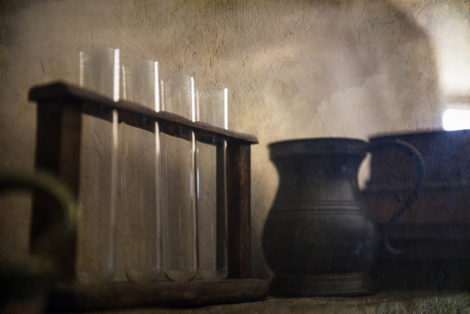
Photo from Newton’s chambers in Woolsthorpe Manor, where he was born and where he also conducted his private studies on mathematics and alchemy. It is said that this is also the property on which the famous apple tree that inspired him to formulate his law of universal gravitation was. Photo: Flickr.
From the age of 12 to 17, Newton attended the King’s School in Grantham, where he learned Latin, Greek, and mathematics. In October 1659, his mother became a widow once again and removed Newton from school, bringing him back to Woolsthorpe-by-Colsterworth in order to turn him into a farmer. Newton disliked the idea and he despised farming, but thanks to the headmaster of his former school who intervened and persuaded his mother to allow him to finish his education, Newton was able to go back and become the top student.
In 1661, Newton received a recommendation from his uncle, Rev William Asycough, with which he was admitted to the Trinity College in Cambridge. He earned his BA degree in August 1665. Soon after that, the university was closed down due to threats of the prevailing Great Plague at the time. Although he didn’t distinguish himself from others as a student while in attendance, Newton was privately studying and developing his theories on calculus, optics, and the law of gravitation at his home in Woolsthrope.
When he returned to Cambridge in April 1667, he was elected as »Fellow of Trinity« and in 1669, after earning his MA degree, he was elected as »Fellow of the Royal Society«, when he had to take the following commitment: »I will either set Theology as the object of my studies and will take holy orders when the time prescribed by these statutes [7 years] arrives, or I will resign from the college.« In 1669, he was also appointed as Lucasian Professor of Mathematics which meant that he did not have to undertake »holy orders« or become an ordained priest.
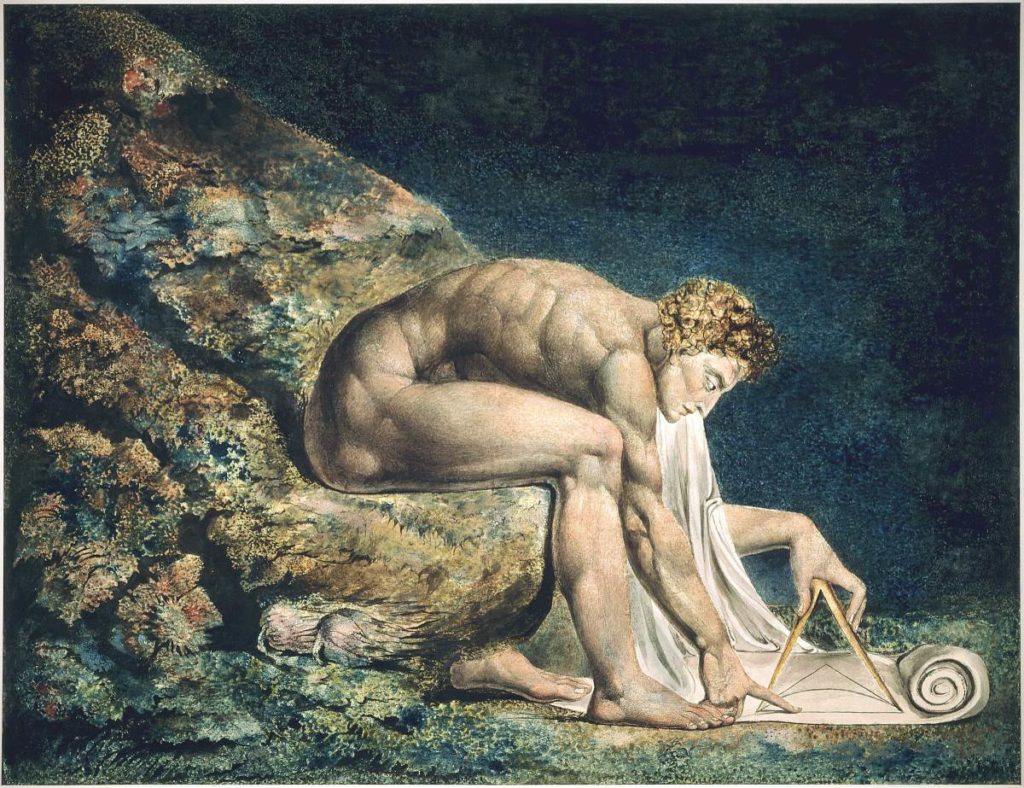
»Newton«. A painting by William-Blake (finished 1795 and reworked 1805) showing Sir Isaac pretty much the way as he is remembered today: A man, a compass, and some mechanical drawings. The romantic and mystic Blake rejected Newton’s deistic worldview and his distinction between spiritual and physical (optical) vision offended him in particular. Accordingly, Blake depicts Newton rather cold – a symbol of the »sterile« worldview of Enlightenment/the Age of Reason, which the poet opposed with passion. For Keynes and the taste of most people today, however, Newton remains closer to the magi.
In 1675 when he was required to commit to his vow, Newton argued that his position as a Lucasian Professor should be enough to discharge him from the ordination. His unorthodox views did not resonate with Anglican orthodoxy, but thanks to Charles II who accepted his argument as a Lucasian Professor, a conflict between his views and that of the church was averted.
In between 1666 and 1684, Newton wrote several mathematical papers that circulated among his colleagues and which gained him the reputation of a proficient and »extraordinary genius«. He also lectured on optics in between 1670 and 1672, when he also researched refraction and made an analysis and resynthesis on the white light which was influenced by corpuscular alchemy, especially as seen in his »Opticks« published in 1704.
In 1675, he published his »Hypothesis of Light«, in which Newton used still the notion of »ether« as a transmission medium for forces between particles. But soon his interest in alchemy was revived, thanks to Cambridge Platonist Henry More (who also influenced Blavatsky’s Isis Unveiled), Newton replaced the »ether« soon with the fundamental hermetic idea of polarity – or »occult forces that were based on Hermetic ideas of attraction and repulsion between particles« as some biographers noted.
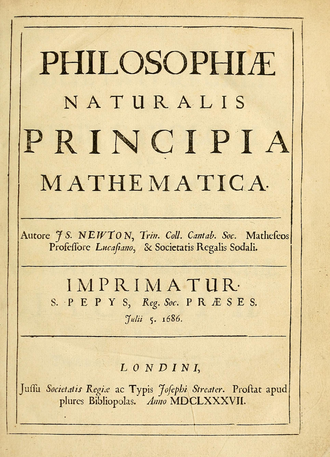
The title page of the »Principia«, first edition (1686/1687) by Sir Isaac Newton
He published his »Principia« (Philosophiæ Naturalis Principia Mathematica) in 1687, which is a work of 3 of his books that state his laws of motion, and which formed the foundation of classical mechanics and his famous law of universal gravitation. Newton’s “Principia” is one of the most important works in the history of science today and it is part of the Scientific Revolution, although at the time its revolutionary waves were not immediate.
The turn of the century came with many changes for Newton. He spent the first part of it writing religious papers, after which he moved to London to take his new position as warden of the Royal Mint first, and soon after as Master of the Mint in 1699. Newton retired from his position at Cambridge in 1701 to fully dedicate to his Master of the Mint duties, which he did for the rest of his life. It has been suggested that Newton thought of his work at the Mint as part of his alchemical practice. In 1703, he was elected as the President of the Royal Society and in the April of 1705, he was knighted by Queen Anne, making him the second scientist to be given the Sir title, after Sir Francis Bacon.
Newton died in his sleep on March 20, 1727, in London and his body was buried at Westminster Abbey. A postmortem examination was conducted on his hair and traces of mercury were found, which many believe was a result of his alchemical practice. It was suggested that his alchemical practice exposed him to mercury poisoning, which could’ve explained his »eccentricity« towards the end of his life as well as his nervous breakdowns earlier in life. In a note he made before his death, Newton wrote:
»I do not know what I may appear to the world, but to myself I seem to have been only like a boy playing on the sea-shore, and diverting myself in now and then finding a smoother pebble or a prettier shell than ordinary, whilst the great ocean of truth lay all undiscovered before me.«
Magical Legacy: The Emerald Tablet
Many of Newton’s works are now considered occult studies. Out of the estimated 10 million words left, about 1 million of them are written on matters of alchemy and over 2 million on religion. Just as Agrippa von Nettesheim or Dom Pernety, Isaac Newton is a perfect example on how science and the occult were still not mutual exclusive. Much more: magicians, alchemists or innovative religious philosophers (such as the Neoplatonists and Bruno) subsequently prepared the ground and even pushed forward modern science in their quest to enlightenment.
Which is also to say that indeed his theory of gravity did not come from »modern«, »rational« science as some still think today, but it was to a large extent a (by)product of Newtons mystical and alchemical science. Nevertheless, despite all his fascination for alchemy and the occult, Newton was a discreet man who kept his interest in the occult successfully hidden from most of his contemporaries.
He may have also chosen not to publish any of his alchemical papers due to the ongoing study and practice which was not yet completed, even after decades of meticulous research and experimentation. Newton was a known perfectionist who would only publish his works once he considered them complete. John Maynard Keynes, the economist who won the auction on half of Newton’s papers on alchemy said that: »Newton was not the first of the age of reason: He was the last of the magicians«. And even though he is not the last, he may have been the last at a time, when both worlds still could coexist quite well together. The mystic and poet William Blake accused Newton (among some other prominent Philosophers of the Age of Reason such as John Locke) to be responsible for the schism, and wished that Newton should burn in hell.
Estefania Wenger writes in her book »Isaac Newton: A Biography« the following: “Some practices of alchemy were banned in England during Newton’s lifetime, due in part to unscrupulous practitioners who would often promise wealthy benefactors unrealistic results in an attempt to swindle them. The English Crown, also fearing the potential devaluation of gold, should the Philosopher’s Stone actually be discovered, made penalties for alchemy very severe. In some cases, the punishment for unsanctioned alchemy would include the public hanging of an offender on a gilded scaffold while adorned with tinsel and other unspecified items.” This further explains Newton’s discretion which might’ve not only been out of caution and aversion of scrutiny and punishment, but also of distinguishing the purpose of his alchemical studies from other practitioners of alchemy of his time.
While the true extent of Newton’s alchemical work is unknown, several of his documents which survived to this day indicates that he was on a quest to create or acquire the Philosopher’s Stone. Newton was deeply inspired by the wisdom of the ancients when it comes to his occult studies. More notably, this can be seen in his book »The Chronology of Ancient Kingdoms Amended«, in which he wrote a chapter on his research on the Temple of Solomon. He was mainly interested in the sacred geometry of the temple, which he believed was built with divine guidance, thus making it more than just a mathematical blueprint.
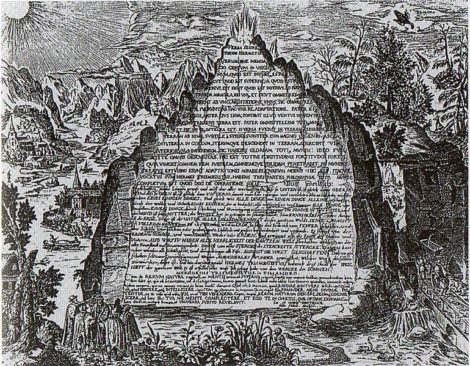
Image from 1606 showing a fictive version of the Emerald Tablet (Heinrich Khunrath,)
But the most important contribution to the popularization of alchemy and hermeticism was probably the translation of the Emerald Tablet (Tabula Smaragdina) from Latin into English. This fundamental piece of alchemical and hermetic writing, alongside the »Corpus Hermeticum«, shapes Western Esoteric thought like few other known texts and is one of the most cited ones. The formula »That which is below is like that which is above and that which is above is like that which is below« has become the fundamental credo for occult currents of all kinds. Often in a shortened version, which says »As above, so below« and »As inside, so on the outside«, omitting the second part, which may very well suggest that the influence works both ways, even though this is not the common interpretation.
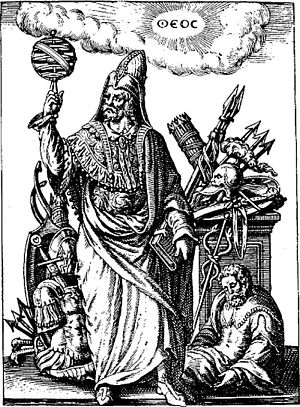
Hermes Trismegistus. The legendary author the »Corpus Hermeticum« and the »Emerald Table«. Newton would be the first translator from Latin into English.
Hermes Trismegistus, the syncretism between the Greek god of magic and his Egyptian counterpart, Toth, fascinated scholars since the Renaissance after Cosimo de Medici acquired in 1462 a Greek copy of the »Corpus Hermeticum« and Neoplatonist Ficino translated it into Latin. The Hellenistic scriptures are nowadays commonly dated between the 1st and 3rd century. The much shorter »Tabula Smaragdina« can be traced into the sixth century, first among Arabic sources, Latin versions spread since the 12th century. Mircea Eliade assumes that the first Latin translation stems from Italian scholar Gerhard von Cremona, Albertus Magnus and Geber are supposed to have known the text.
For Hermeticians, it summarizes until today in a short and beautiful manner the basic principles of hermetic science. However, it’s outstanding simplicity is not less deceitful, than putting all the principles of mathematics on one single DIN A4 paper – which would be quite possible, but for most people not practicable or helpful, as the large body of mathematical literature suggests. Thus, the best way to see and approach the Tabula Smargdina is the same way as Bruno’s mnemonic devices: a memory hook for what we already know, and a guide for study, contemplation and further meditation for what lies ahead.
The translation made by Isaac Newton of the Emerald Tablet, which is today kept in the King’s College Library at the University of Cambridge, reads as follows:
The Emerald Table as Translated By Isaac Newton
- Tis true without lying, certain and most true.
- That which is below is like that which is above and that which is above is like that which is below to do the miracles of one only thing
- And as all things have been and arose from one by the mediation of one: so all things have their birth from this one thing by adaptation.
- The Sun is its father, the Moon its mother, the wind hath carried it in its belly, the earth is its nurse.
- The father of all perfection in the whole world is here.
- Its force or power is entire if it be converted into earth.
- Separate thou the earth from the fire, the subtle from the gross sweetly with great industry.
- It ascends from the earth to the heaven and again it descends to the earth and receives the force of things superior and inferior.
- By this means you shall have the glory of the whole world
- And thereby all obscurity shall fly from you.
- Its force is above all force. For it vanquishes every subtle thing and penetrates every solid thing.
- So was the world created.
- From this are and do come admirable adaptations whereof the means (or process) is here in this. Hence I am called Hermes Trismegist, having the three parts of the philosophy of the whole world
- That which I have said of the operation of the Sun is accomplished and ended.
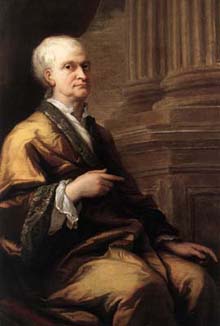
Portrait of the old Isaac Newton (1643-1727) by James Thornhill
His translation of the tablet is his most well-known and highly appreciated attempt to »update« ancient knowledge and reconcile it with his then present age. Furthermore, with his translation of the tablet, there was also a commentary that he made, part of which reads:
“And in whatsoever way the world has been made from the dark chaos through the production of light and the separation of the waters of the firmament of the air from those of earth, so our work was created from the black chaos and its prime matter through a separation of the elements and their illumination, and leads to the origin of matter. Whereby arise adaptations and marvelous arrangements in our work, the mode of which is concealed within the creation of this world. On account of this art Mercury is called thrice greatest, having three parts of the philosophy of the whole world, since he signifies the Mercury of the philosophers, which has and is made up of the three most powerful substances, body, soul, and spirit and has dominion in the mineral kingdom, the vegetable kingdom, and the animal kingdom.”
Newton’s magical legacy does not only stand in the translation of the Emerald Tablet, but also in the power of his own example as a passionate alchemist who did not separate the “quintessence” from his scientific discoveries.
Bonus: Isaac Newton’s Contributions to »The Crowning of Nature« Explained by Dr. R.A. Pilmer
Figure from the Text “The Crowning of Nature” by Sir Isaac Newton. Dr. R.A. Pilmer from Courtyardalchemy.com was so kind to comment the symbolism for NettlesGarden.com
»The Crowning of Nature« is an Elizabethan text on alchemy. Newton probably had a copy of a preceeding text and enriched it by adding the color symbolism. He labelled it the Lapis Philosophorum or Philosopher’s Stone – sometimes regarded as the goal and active principle of alchemy.
He also wrote numbered colouring instructions (his interest in optics) alongside, for black, green, blue, yellow and red. In the original manuscript, it appeared as the first figure named Chaos; a central disk is surrounded by seven smaller disks, each segmented by a seven-pointed star. Signs of the seven most notable heavenly bodies (the planets Mercury, Venus, Mars, Jupiter and Saturn, plus the Sun and the Moon) these are then assigned to the points of each star, and inscribed in rings around each disk. The archetypal forces of the seven planets surround the four elements of earth, water, air and fire in the centre.
Out of these ingredients, the Great Work of alchemy proceeds. The use of esoteric symbolism seems at odds to the modern eye, especially at the hand of the man who established our understanding of the solar system. However, Newton believed in the possibilities of alchemy, writing over half a million words on the subject. The planets are also the common symbols for metals: Saturn lead, Jupiter tin, Mars iron, Venus copper, Mercury quicksilver, Moon silver and the Sun gold. For Newton, they were transformed by a vital spirit under the Decknamen »magnesia«, »mercurial spirit«, »body of light«, etc…, it was responsible for all growth and decay, and representing God’s will at the heart of all matter.

www.Nettlesgarden.com – The Old Craft


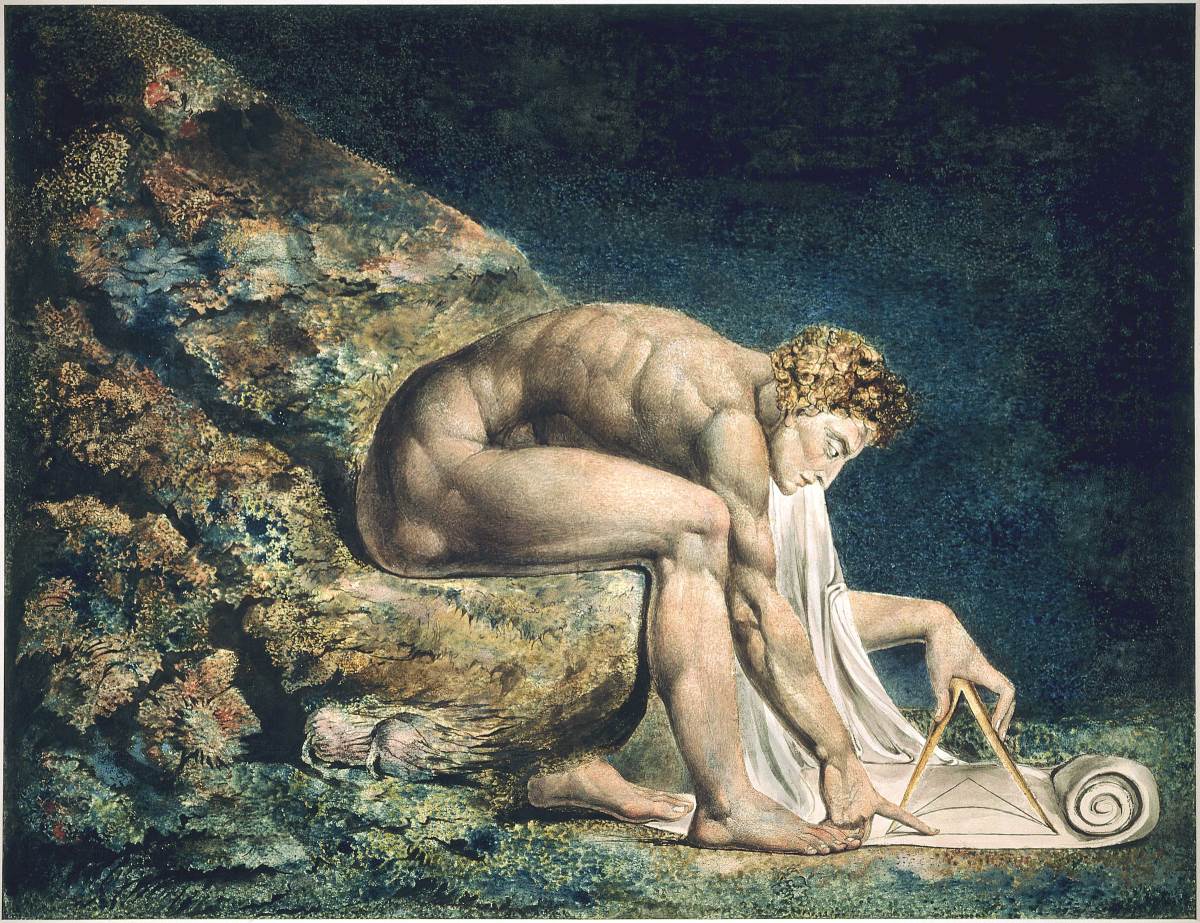
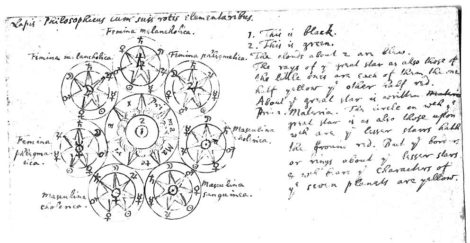
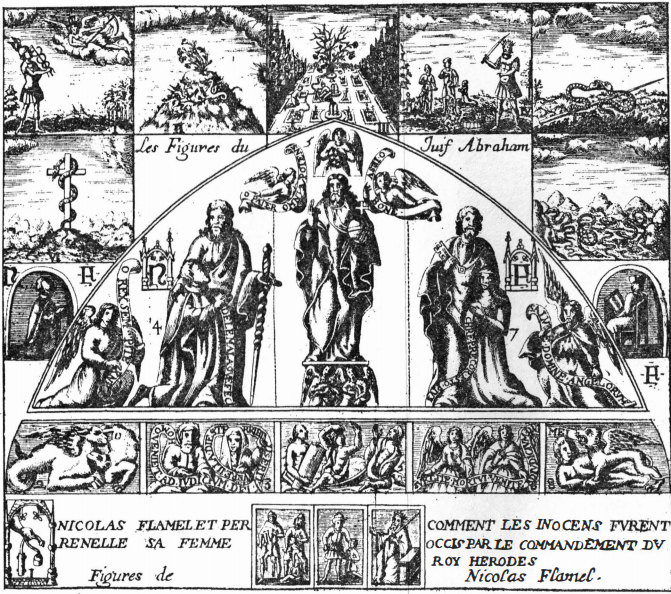
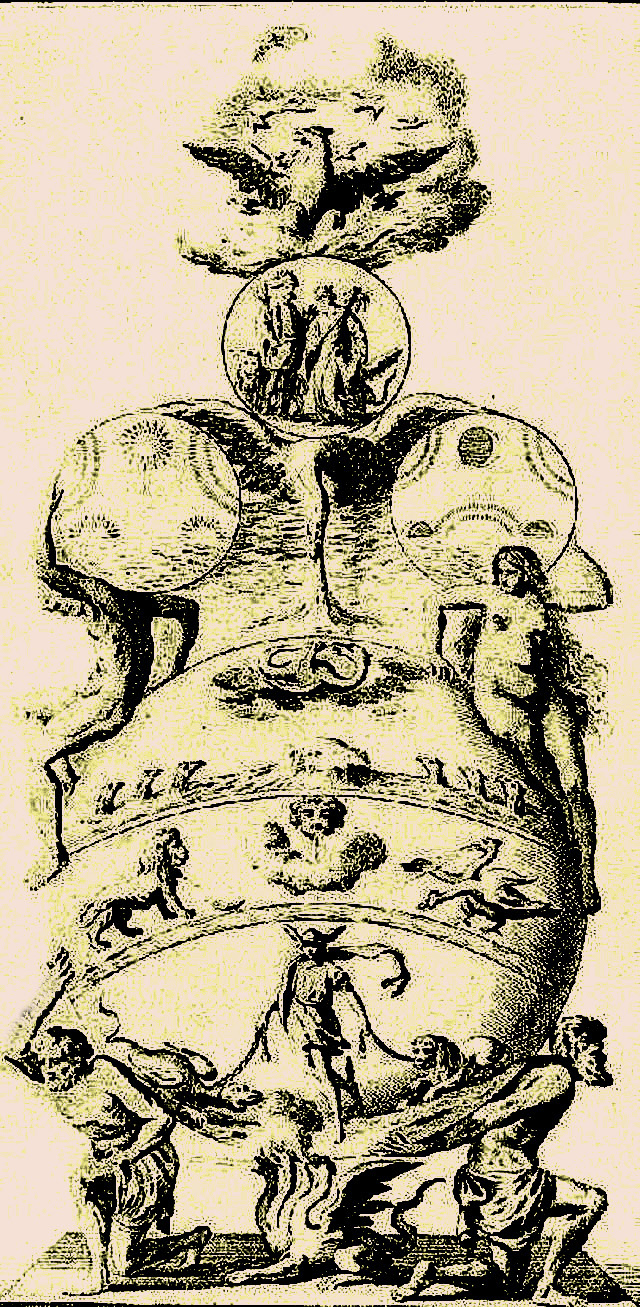
Robert Anderson Plimer | March 20, 2018
|
In alchemy, Newton was fascinated by Antimony and was clearly able to create the reguli from the 7 planetary metals – hence a reference to the importance of Newton’s notebooks and your circular diagram.
Mark A. O'Blazney | March 21, 2018
|
And then came Boyle’s corpuscle theory
Marie | February 26, 2023
|
Does anyone know where one could find a full copy of Newton’s translation of the great emerald tablets?
Nettle | April 5, 2023
|
Hello,
this one is a good read https://www.sacred-texts.com/alc/emerald.htm to start with.